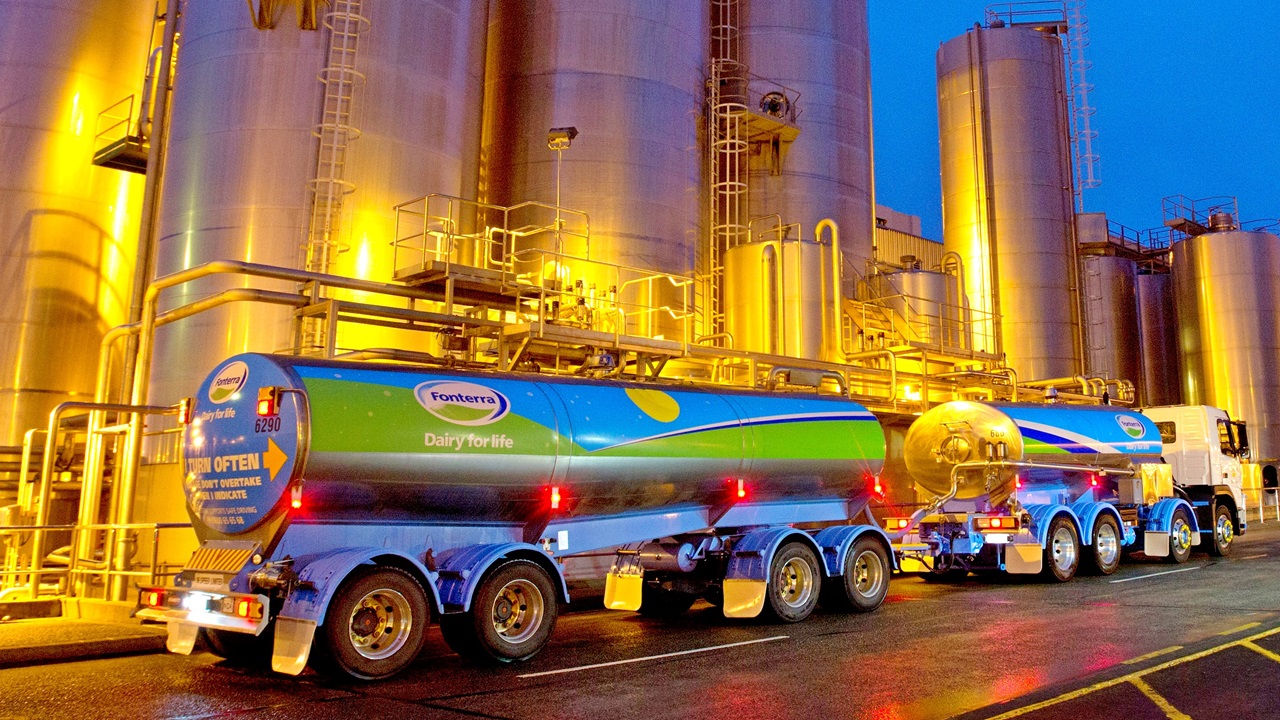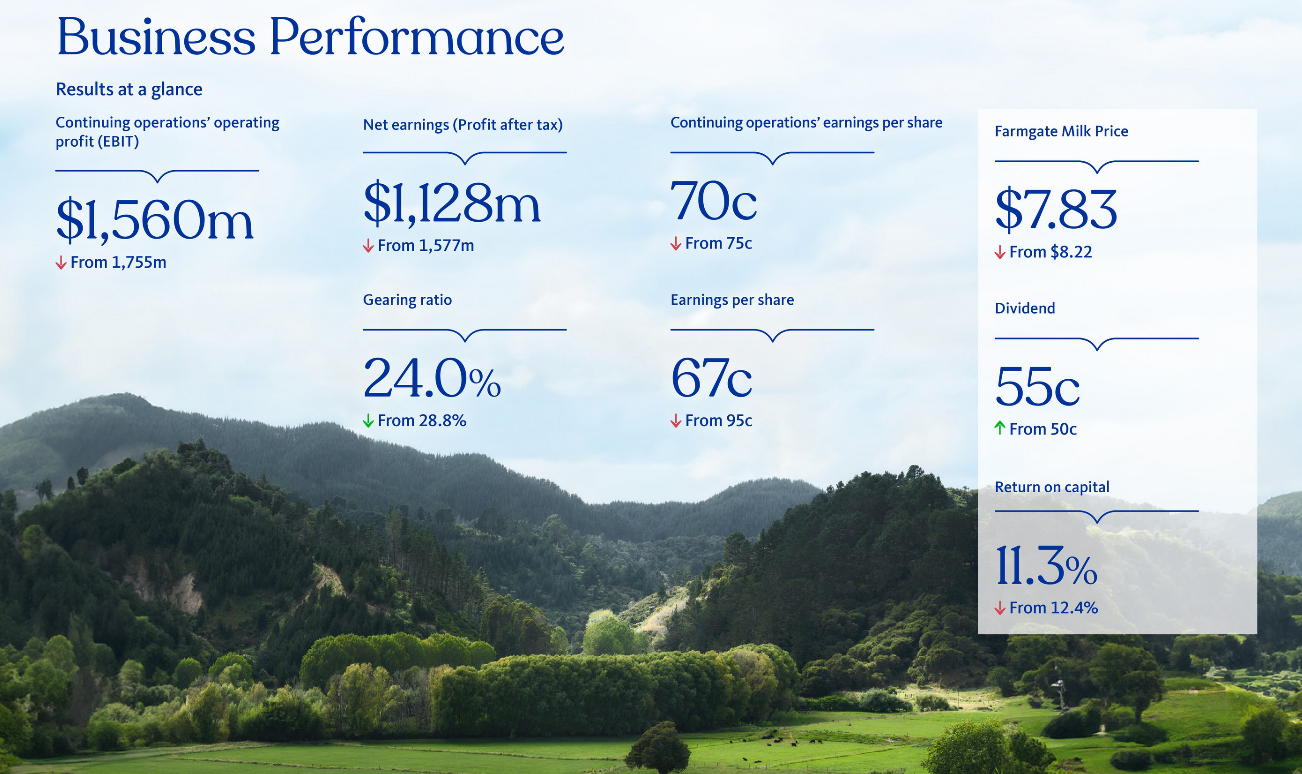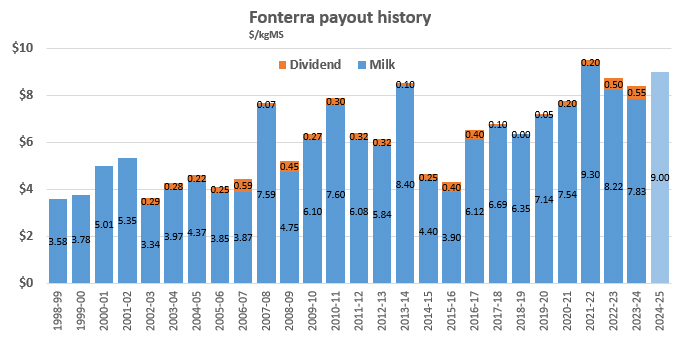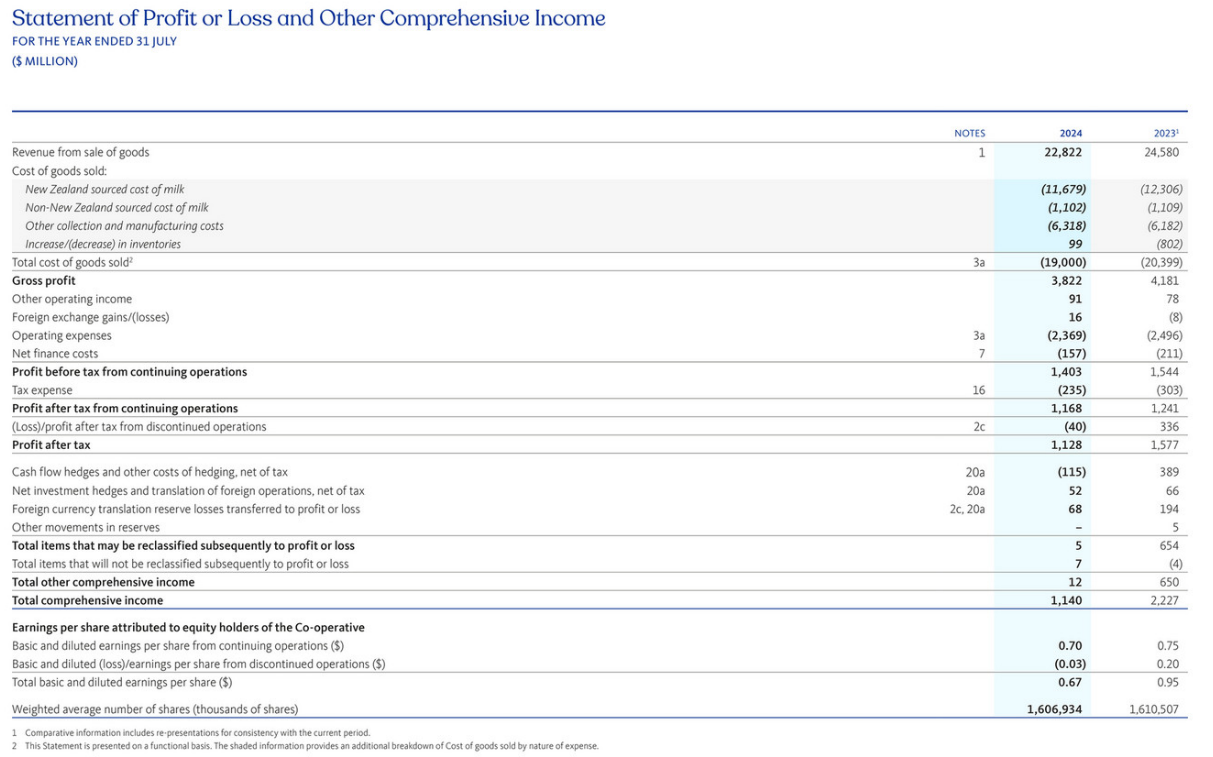
Dairy co-operative Fonterra has hiked its forecast milk price to farmers for the current season to an effective $9 per kilogram of milk solids, which will be the second largest payout ever if achieved.
The 50c rise in milk price forecast comes as the company announced a reduced after tax profit for the year ending July 2024 of $1.128 billion, down from the record $1.577 billion in 2023. The prior year's figure included over $300 million from subsequentlly discontinued (sold) operations.
Revenues were $22.822 billion, down from $24.58 billion in 2023.
In terms of continuing operations, the after-tax profit was $1.168 billion compared with $1.241 billion in 2023. Total borrowings were $3.388 billion compared with $3.9416 billion in 2023.
The co-op announced a total dividend for the 2024 year of 55c, which was up on 50c from last year.
The dividend in the latest year included the already paid interim dividend of 15c, a final dividend of 25c and a special dividend of 15c.
The final milk price for the year just past has been set at $7.83, meaning farmers are getting a full payout of $8.38 for the 2024 financial year.

When giving guidance on the expected milk price Fonterra forecasts a range. In terms of the milk price forecast for the season currently under way, Fonterra’s new forecast range is $8.25-$9.75 per kgMS. This gives a 'mid-point' of $9.
Fonterra chief executive Miles Hurrell says the lift in this season’s forecast Farmgate Milk Price follows further recent strengthening in global dairy trade prices and constrained milk supply in key producing regions.
"I’m pleased to be announcing an increase in this season’s forecast Farmgate Milk Price, which I’m sure will be welcome news for farmers, particularly when combined with the 55 cent total dividend for FY24 also announced by the co-op today," Hurrell said.

The full year profit in 2024 represented earnings per share of 70c.
However, the company's signalling lower earnings per share for the 2024-25 year in a range of 40c-60c per share and is citing the fact that "after several years of strong earnings performance, the co-op exhausted its tax losses in FY24 and will now be paying tax".
The co-op says this change will reduce its reported earnings per share in future years, as Fonterra will have paid the tax on the cash to be distributed. Imputation credits will now be available.
In the annual report Fonterra reported that Hurrell was paid $5,924,782 in the 2024 year, up from $4,607,582 last year. The fixed component of his remuneration rose to $2,459,310 from $2,367,501 in 2023.
The co-op said as of July 31, 2024 it directly employed 16,441 people. The remuneration part of the report states that during the year 11,381 employees, of whom 8,821 were based in NZ, were paid in excess of $100,000. The 2023 annual report showed that the comparative figure then was 10,356 employees (7,865 in NZ) that were paid in excess of $100,000.
Back in May 2024, Fonterra surprisingly announced that it was putting a number of its consumer businesses on the block, including household-name brands such as Anchor and Mainland. It gave a timeframe for a sale of 12-18 months.
In a brief update on this, Hurrell said over the last few months, the co-op had appointed advisors to assist with assessing divestment options for the consumer businesses "and this work is ongoing".
The co-op remained "committed to a pathway that would maximise value of these businesses for our farmer shareholders and unit holders".
He said alongside this, Fonterra had "revised our strategy to have a sharper focus on the Co-op’s strengths and where we can best create value".
"We will be sharing this revised strategy, as well as the outcomes shareholders and unit holders can expect from the co-op, next week."
Fonterra chairman Peter McBride said during the 2024 financial year the co-op received "unsolicited interest" in parts of the consumer businesses.
"The world has changed. We have entered a new era of global competition, not cooperation," he said.
"It’s a more expensive, competitive and volatile world where customer expectations are evolving, and New Zealand milk and capital are becoming scarcer.
"Having a co-op that is aligned to our comparative advantage is fundamental. The strategic review has clarified the parts of the business that generate the greatest returns for farmers today, and highlighted where we see further headroom for growth," McBride said.

17 Comments
Need more scientists, not fewer. More R & D funding, more grants for tech and biotech PhDs
Otherwise NZ will always be reliant on cows, a sunset industry if ever there was one.
Mooo🥂
Suns been setting for 30 plus years.
Cote d Azur
Nothing stopping you from developing Tech and Bio tech now, just go and do it given it so easy, in the mean time keep your disparaging remarks to your self.
Dairy exports continues to allow the current lifestyle and standard of living for the Nz population.
Disagree. Debt is what fuels our current living standards.
Is the grass going to stop growing? What have i missed?
No.. In fact there will be a renasonse..brought about by technology..
And a sunrise, or more correctly pre-sunrise industry.
Remember the ditty early to bed, early to rise.....
Touchy touchy cow lovers!
Moooody lolz.
Merely suggesting NZ would do well to look ahead.
Not going to create a Google or Pfizer with our heads stuck up cows bums!
🥂
I understand the sentiment; perhaps you are addressing it the wrong way.
NZ's food and fibre makes up less than 11 percent of NZ's GDP but makes up 80 percent of merchandise exports and 67 percent of total exports.
The way I read this is that the remaining 89% of economy is barely producing enough of anything that the world is willing to buy at a premium.
Auckland makes up 38 percent of NZ's GDP but barely contributes 8-9 percent of the country's exports, much of which I suspect is from clipping tickets as a gateway to the regions.
It is my understanding that the GDP figure for food & fibre is very narrowly focused and does not take into account the multitude of businesses supporting these sectors. If they were then the figure would be significantly higher than 11%.
Look at you figuring out what an economy means. Did you think until now it was just a bunch of sectors operating in complete silos.
Jokes aside, 11% still paints a concerning picture of the lack of export diversification in NZ. We are 56th in the world on export complexity just below Ukraine.
That was the mantra in the 90s.....agriculture is a sunset industry.....welcome the knowledge economy.
Where the heck did that get us....?
We are walking a very fine line when Europe production is down because of Government enforced environmental regulations to reduce agriculture's impact on climate change.
We get to reap the benefit of less global competition but only until processors and retailers force the same rules on NZ. It is coming - look at Nestle's increasingly frequent public statements on how we need to improve.
The really good news is Dairy still has a profitable future - even without China.
Be specific please on the environmental standards regulated in the EU jurisdiction vs NZ.
Of course Nestlé will bleat - its got a vested interest in reducing Fonterra competitiveness in global trade.
Shows how useless the current Govt are, as soon as they get involved things tank
Leave them out like Fonterra & things flourish
New Zealand is a low population, isolated country, with a a perfect climate for growing cheap grass. Other than pretty mountains for tourists to look at, what else do we have going for us, that would allow us to compete with the rest of the world on any other industry?
People who say the sun will set on the dairy industry, don't understand the unmatched efficiency of ruminant animals to turn crude protein into a source of protein humans can ingest (which is different from digest). It would defy the laws of physics, if a machine came along that could produce milk or meat as environmentally or energy efficiently anywhere close to that of a ruminant animal. It will never happen and it's why lab grown meat/milk products will continue to fail.
Huge technological advancements are being made in the NZ dairy industry. Just look at all the wearables and their ability to reduce reliance on labour. The down the throat monitoring devices will be a game changer. If anything we should be investing more in agriculture to develop these technologies ourselves, so that we can sell it to the rest of the world.
That's why I think we would be better off going for a higher price, rather than quantity.

We welcome your comments below. If you are not already registered, please register to comment.
Remember we welcome robust, respectful and insightful debate. We don't welcome abusive or defamatory comments and will de-register those repeatedly making such comments. Our current comment policy is here.